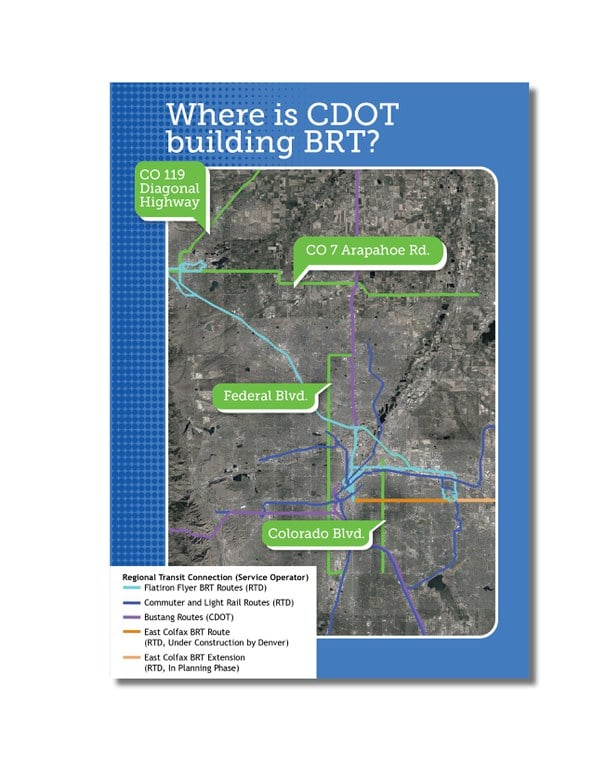Denver Metro Bus Rapid Transit (BRT) Project
About the Project
The Colorado Department of Transportation has launched a new Bus Rapid Transit (BRT) program with routes planned for sections of Federal Boulevard, Colorado Boulevard and eventually Colfax Avenue east of I-225. The program focuses on planning and developing a BRT system in collaboration with the community and agency partners. Strong public and community engagement is critical to the success of the BRT program. CDOT will have robust public outreach opportunities, including workshops, interviews and other tactics that will be listed in this web page.
BRT is a high-capacity, efficient bus service that incorporates elements of light-rail. These include stations, all-door boarding, purchasing tickets before riding, priority at intersections, and in some locations dedicated bus lanes. This attractive, high frequency transit service is designed to be more reliable, convenient, and accessible than traditional bus service. BRT achieves high quality service because it reduces delays that can typically slow regular bus service, like making long stops or getting stuck in traffic at intersections.
Schedule & Important Dates
Fall 2025 Public Open Houses
- Wednesday, Oct. 29
5 to 7 p.m.
The MAC
3295 W. 72nd Ave.
Westminster, CO 80030 - Thursday, Oct. 30
5 to 7 p.m.
Westwood Community Center
1000 S Lowell Blvd.
Denver, CO 80219
What is BRT?
Project Areas
BRT Routes in Development or Planned
The following routes were moved ahead in the planning, design and implementation phases as a result of studies and public engagement by the Regional Transportation District (RTD) and the Denver Regional Council of Governments (DRCOG) Metro Vision 2050 and Denver Moves Transit:
- Federal Boulevard from 120th Avenue in Westminster to Dartmouth Avenue in south Denver (18 miles) - Environmental study and design work is underway
- Colorado Boulevard from I-70 to I-25 (6.5 miles) - Multimodal corridor study is underway
- Colfax from Union Station to I-225 (10 miles) - Moving toward construction, a Denver Department of Transportation and Infrastructure (DOTI)project
- East Colfax Avenue from I-225 to I-70 (5 miles) - An extension is envisioned
- CO 119/Diagonal Highway from 47th Street in Boulder to Hover Street in Longmont - Design work is finished with construction planned soon
- CO 7/Arapahoe Road from Boulder to Brighton (25 miles) - In development
Where is CDOT building BRT?

Download the BRT map (PDF)
- Deliver an important part of CDOT’s 10 Year Plan to expand high quality transit option in the Denver area, including ongoing collaboration with regional partners to leverage new sources of federal funding
- Meet the Colorado Transportation Commission’s commitment to reduce greenhouse gas emissions
- Improve transit for existing riders and add high-quality service for new ones
- Connect urban corridors and communities, providing vital transportation options that allow better access to jobs, shopping, health care, education, recreation and many other destinations
- Partner with the community and stakeholders to develop the best BRT routes possible
- Reliable, high-frequency bus service along some of the most congested routes in the Denver region
- Safe, accessible and affordable transportation choices for all travelers
- Improves safety by helping to prevent crashes involving pedestrians, bicyclists and vehicles on heavily traveled urban roads
- Increases the number of people who can travel on a road while using fewer vehicles, ultimately easing congestion and reducing greenhouse gas emissions
CDOT is working with the Regional Transportation District (RTD), the City and County of Denver, the Denver Regional Council of Governments (DRCOG), the Federal Transit Administration (FTA), and local partners to deliver BRT on state highways in the metro region.
